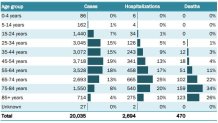As of Monday, April 13, Florida continues to see a steady daily increase in the number of coronavirus cases confirmed by the state's Department of Health. A total of 20,601 cases have been reported, as Florida officials continue to open more testing sites and expand the criteria for who can access a test.
The daily reports provided by the Florida Department of Health can offer some insight into how the state's coronavirus outbreak is unraveling, such as information on which regions or which demographics of people are most affected. Below are 10 such questions and answers regarding COVID-19 in Florida.
It is important to note that since this information is limited to data provided by the Department of Health, and might not include complete figures from all of the state's private testing facilities or private hospitals due to delays in data processing, it may not accurately capture the actual scope of the state's COVID-19 outbreak.
When was the first case of coronavirus reported in the state?
The first two cases of coronavirus in Florida were confirmed on March 1st, after which a state of emergency was immediately declared.
The cases were two residents from Hillsborough and Manatee counties, in the Tampa Bay area. The case in Hillsborough was linked to travel from Italy.
How many tests are issued on a daily basis?
Local
In the last seven days, testing sites and facilities have conducted 11,108 daily tests on average. On Sunday, April 12th alone, 12,388 tests were administered.
This number could increase in the coming days as more testing centers are opened and government-funded sites start to expand their criteria for who can get a test administered.
Which counties and cities have the largest number of cases?
Miami-Dade and Broward are the counties that tally the largest amount of cases. As of Sunday's data, Miami-Dade claimed more than 36% of the state's total count of cases, and Broward claimed 15%. Between the two counties, they constitute more than 50% of confirmed COVID-19 cases in Florida. In third place is Palm Beach county, with 8% of the state's cases.
The three cities with the highest number of cases are Miami (Dade), Hollywood (Broward) and Hialeah (Dade). Click here to see the map with the full list of South Florida cities and their corresponding number of cases.
How many administered tests have come back negative?
As of Monday, April 13th, a total of 196,819 tests have been administered, according to the department's data, 175,606 of which have come back negative and 20,601 of which have come back positive.
This is to say, 89.20% of tests are negative and 10.47% come back positive for COVID-19. The rest are inconclusive or still awaiting results.
What's the age demographic with the largest number of cases?
The age group with the most number of COVID-19 cases is between 45 and 54 years old, with those people accounting for 19% of cases. Next are those between 55 and 64, which account for 18% of cases. The group from 35 to 44 years old and the group from 25 to 34 both account for 15% of cases.
It's worth noting that federally-funded testing sites have most aggressively focused on testing first responders and people over the age of 65, since those groups are considered to be the most vulnerable, so this data might be skewed and these figures may not accurately represent the reality of which age groups are most affected by the virus.
Is there a gender divide in the number of positive coronavirus cases?
50% of cases confirmed by the state have been men, and 49% have been women. 1% did not identify gender.
How many people are hospitalized of those who have tested positive?
Out of 20,601 confirmed positive cases of coronavirus, some 2,694 have needed hospitalization, which represents 13.08% of positive cases.
Again, that figure is limited to data provided by the state, and does not accurately reflect the number of people actually hospitalized from the coronavirus in Florida.
Which age group has the most fatalities from the virus?
Of the 470 deaths that have been reported by the state as of Monday, April 13th, 82% have been people who were older than 65 years old. 11% of deaths have been people between 55 and 64 years old.

How does Florida's outbreak compare to that of other states battling the pandemic around the United States?
As of April 13th, Florida is the ninth state with the most confirmed cases in the U.S.:
- New York
- New Jersey
- Massachusetts
- Michigan
- California
- Pennsylvania
- Illinois
- Louisiana
- Florida
When is Florida's peak expected to be as far as medical attention requirement for coronavirus patients?
At the state level, the University of Washington's Institute for Health Metrics and Evaluation estimates that the demand for medical resources in Florida due to coronavirus patients will reach its peak on the 21st of April. This is 12 days earlier than what the Institute had originally estimated, according to an investigation by NBC 6.
These models are based on information about which areas have been affected most, as well as how early and how aggressively these areas shut down schools and other operations.
They predict that Florida will have enough hospital beds in general to manage this peak, although there may be a shortage of around 769 beds in intensive care units.
This story will be updated daily with data from Florida's Department of Health.



